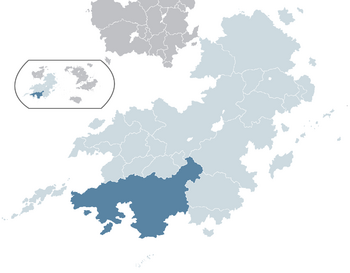Wulin government: Difference between revisions
Britbong64 (talk | contribs) No edit summary |
Britbong64 (talk | contribs) No edit summary |
||
| Line 42: | Line 42: | ||
|flag_s2 = | |flag_s2 = | ||
|image_s2 = | |image_s2 = | ||
|image_flag = Flag of Xiaodong 1934-1936.png | | image_flag = Flag of Xiaodong 1934-1936.png | ||
| | | image_flag2 = Flag of Shangea 1937-1939.png | ||
|flag_type = Flag | | flag_type = Top: Flag<br/>(1935–1937; 1939-1940)<br/>Bottom: Flag<br/>(1937–1939) | ||
| | | | ||
|image_coat = State of Xiaodong CoA.png | |image_coat = State of Xiaodong CoA.png | ||
| Line 55: | Line 55: | ||
|capital = [[Baiqiao]] | |capital = [[Baiqiao]] | ||
| | | | ||
|national_motto = | |national_motto = {{lang-zh|labels=no|和平反共建國}}<br>''Peace, Anti-Communism, National Construction'' | ||
|national_anthem =[https://www.youtube.com/watch?v=Q5hniVjHjY0 爱国歌<br>Patriotic Song] <small>(1935-1939)</small><br> [https://m.youtube.com/watch?v=GsPqHAfdU7w 山川秀丽的土地<br>Land of Magnificant Mountains and Rivers] <small>(1939-1940)</small> | |national_anthem =[https://www.youtube.com/watch?v=Q5hniVjHjY0 爱国歌<br>Patriotic Song] <small>(1935-1939)</small><br> [https://m.youtube.com/watch?v=GsPqHAfdU7w 山川秀丽的土地<br>Land of Magnificant Mountains and Rivers] <small>(1939-1940)</small> | ||
|common_languages = {{wp|Chinese language|Shangean}} | |common_languages = {{wp|Chinese language|Shangean}} | ||
Revision as of 20:33, 26 August 2023
Republic of Shangea 晓东共和国 Xiǎodōng Gònghéguó | |||||||||
|---|---|---|---|---|---|---|---|---|---|
| 1935–1940 | |||||||||
| Motto: 和平反共建國 Peace, Anti-Communism, National Construction | |||||||||
| Anthem: 爱国歌 Patriotic Song (1935-1939) 山川秀丽的土地 Land of Magnificant Mountains and Rivers (1939-1940) | |||||||||
 | |||||||||
| Capital | Baiqiao | ||||||||
| Common languages | Shangean | ||||||||
| Government | Parliamentary republic (1935-1937) Military dictatorship (1937-1940) | ||||||||
| Premier | |||||||||
• 1935 | Qin Xinyi (first) | ||||||||
• 1940 | Hu Yingjiu (last) | ||||||||
| Legislature | National Assembly | ||||||||
| History | |||||||||
• Declaration of the Republic | 15th January 1935 | ||||||||
| 20th September 1935 | |||||||||
• Surrender of Baiqiao | 13th October 1940 | ||||||||
| Population | |||||||||
• 1940 | ~150,000,000 | ||||||||
| Currency | Kuai | ||||||||
| |||||||||
| Today part of | |||||||||
The Republic of Shangea (Xiaodongese: 晓东共和国; Xiǎodōng Gònghéguó) was a state that ruled over much of modern day Shangea that was created in following the abdication of the Taiyi Emperor. It was dissolved following the victory of the Army of National Salvation in the Shangean Civil War and creation of the Auspicious Republic of Shangea in 1940.
The Republic of Shangea was created after the premier Qin Xinyi announced the abdication of the Shanrong Emperor in the closing days of the Great War as Grand Alliance (predominantly Senrian) forces advanced throughout the country. The republican regime was initially popular with its promises of peace and freedom broadly accepted after years of war, militarism and repression. However the Treaty of Keishi which ended the Great War in Coius entailed the breakup of much of Shangea's pre-war territory as well punishing reparations, leading to various groups to criticise the republican establishment for "betraying the country". A series of unstable cabinets fell over this period as the government was unable to deal with mounting social and political chaos.. In September 1933 a failed coup (the Corrective Revolution) led to the official start of the Shangean Civil War fought between the Baiqiao-based government, Lu Keqian's Army of National Salvation, separatist forces and a variety of regional warlords.
Between 1935-7 the government in Baiqiao lost large amounts of land to rebel forces alongside seeing a deterioration in the economic situation. The political sphere became increasingly compromised as military officers ran the country as a de facto military dictatorship sapping their support. An offensive known as the Northern Reconquest was unsuccessful in 1938, with the army never recovering from its defeat at the siege of Lukeng.
The failure of the republican government to overcome political, economic and military problems alongside lingering resentment against the Treaty of Keishi led to the complete military defeat of the state in 1940 and the surrender of Baiqiao to Lu Keqian's forces.


